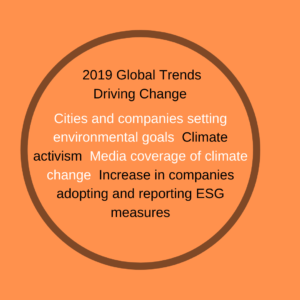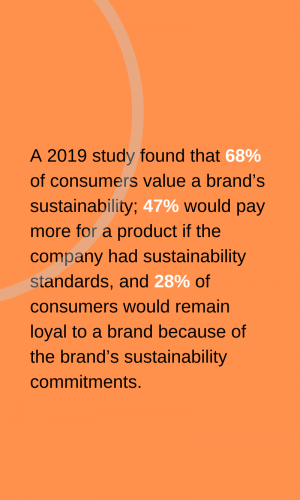It’s barely been six months since we opened our doors as 350Solutions and, to date, our team has been hard at work laying the foundation for our role in the cleantech and low-carbon industries. Happily, our dedication to improving clean technologies and their impacts through evaluation, demonstration, and verification will continue into 2020. Coming up this year, we will have our first (of hopefully many) ISO 14034 ETV issued in the spring and look forward to exciting announcements in the second half of the year as the NRG COSIA Carbon XPRIZE finishes up and awards its winners.
As much as 2019 was an eventful year for us, it was critical year for activity in the carbon and cleantech industries. In this blog post series, I wanted to take some time to discuss the critical climate/carbon impact and cleantech trends we witnessed in the second half of 2019, how different sectors have responded, and what we here at 350Solutions expect to see and do in 2020 in working towards supporting the expanding role of cleantech in achieving sustainability goals and associated environmental and clean-tech targets. This entry will focus on the year 2019 in review, examining the trends we experienced and how some industries are responding.

GLOBAL TRENDS DRIVING CHANGE IN 2019
The first climate impact and cleantech trend we saw, shortly after our startup was the rise of climate activism on a massive, global scale. There were large-scale rallies in Berlin, Germany, around the UN Climate Summit, and Madrid, Spain, for COP25, in support of driving measurable changes to how global governments address their responsibilities towards climate change. Climate Strike was a major event globally, with a strong showing by the next generation of activists. In addition to global rallies, there were also sustained efforts of climate activism from organizations including the Sunrise Movement, Friday’s for Future, and 350.org that worked to apply pressure to political parties, governments, and companies in order to enact change on local levels. One of the key differences this year, compared to historical efforts, is that many of these new voices were those of passionate leaders from younger generations.
The next trend we witnessed developed in response to the lack of global action on how to address climate change. Cities and companies are continuing to set their own climate and environmental goals, some meeting the levels outlined within the Paris Agreement and the Climate Ambition Alliance. From a business perspective, the number of companies adopting Environmental, Social, and Governance (ESG) measures continues to increase. Some businesses are adopting ESG measures because they align with company values or mission, but we area also seeing outside market forces drive companies to adopt. Investors, financers, and insurers are beginning to push for ESG reporting as part of their assessment of the overall financial stability of a company and now more than ever, consumers are making buying decisions based on a company’s sustainability and environmental commitments. And, science-based targets are also being adopted to ensure that corporate targets have a basis in science and quality data, and are being tracked with more rigor to ensure they have the intended impacts – not just greenwashing.
The final global climate impact and cleantech trend we saw in 2019 was in how media covered and discussed climate change and the impacts of carbon dioxide (CO2) emissions. The launch of the Covering Climate Now agreement, which has been signed by more than 350 global media outlets, is a commitment to covering and publishing stories related to climate issues. The potential impact of this agreement is critical in helping spread awareness and increase a collective understanding of the causes and impacts of climate issues for more than 1 billion potential readers.
REPORTS
2019 was a critical year in the publication of analytical reports related to the current and future impacts of CO2, climate change, and clean technologies, and how we can address those issues on a global scale. With the UN Climate Summit in September, we saw the publication of the Exponential Road Map, that listed 36 solutions to cut greenhouse gas emissions 50% by 2030 worldwide, across six different sectors: energy, industry, transport, building, food consumption, and nature-based solutions. Then there came the Energy Future’s Initiative publication of the Clearing the Air Summary, that outlines a ten-year RD&D initiative to bring innovative carbon dioxide removal (CDR) technologies to market at a gigaton scale. The Ellen MacArthur Foundation and Material Economics updated the Completing the Picture: How the Circular Economy Tackles Climate Change report and highlighted the need for a fundamental shift in how the circular economy tackles climate change by 2050 in order to reach a net zero emissions in the consumption of steel, plastic, aluminum, cement and food. And finally, the year ended with the UN Climate Change Conference COP25 with the publication of the Climate Action Pathways with the Marrakech Partnership and the renewal of the Climate Ambition Alliance which outlines a long-term vision for 1.5 climate-resilient world and sets out actions needed to achieve those goals in the years of 2020, 2030, and 2050 across energy, human settlements, industry, land use, oceans and coastal zones, transportation, and resilience.
INDUSRTY TRENDS
Within the industries that are addressing carbon emissions it was an exciting year of developments, innovations, and investments. We saw the launch of new carbon marketplaces focused on actualizing investments and results. While carbon marketplaces have been growing in popularity, the key difference is now there is real conversation happening about how to create measurable results and improvements in carbon emissions as part of these marketplaces, incorporating verification to ensure impacts are known and real. And at the World Economic Forum in Davos in January of 2020, Prince Charles announced the “Sustainable Markets Initiative,” designed to reorganize markets according to sustainable environmental business practices.
We saw a clear growth in numbers of cleantech accelerators, across the United States, some being championed by private investors while others are being run with the support of host cities. These accelerators are powerful incubators for the innovators and innovations that will propel us closer to meeting the climate and environmental goals needed to prevent further destruction.
Similarly, we saw new carbon and environmental conscious innovation competitions focused on driving global creativity in finding impactful solutions for to help the environment. For example, XPrize launched the Rainforest XPrize challenge, investing more than $10 million in a competition for technologies that can help survey and protect biodiversity in rainforests. And the last day of 2019 brought the launch of The Earthshot Prize from Prince William, a $10 million dollar competition dedicated to developing solutions that will address the effects of climate change and help protect the environment.
Finally, the finance sector continues to expand the climate and environmental impact focus. In addition to incorporating climate and ESG focused metrics in investment decisions more and more – see Blackrock’s announcement of its new climate commitments – new financing mechanisms are appearing to take a stronger foothold. Green Bonds, Sustainability Linked Loans, and blended finance – which incorporates traditional capital investment with low or no return philanthropic or other investment in higher risk portfolios (such as cleantech and carbon removal) are all growing. Investment in green bonds increased by 26% in 2019 and impact investing levels increased by over 13% according to GIIN. And, philanthropy isn’t just about giving out grants anymore – especially in the climate change space.

It’s almost overwhelming seeing all that we witnessed just in the last five months of 2019 in climate impact and cleantech trends written down in one place. What about you? Do you agree with our assessment of 2019? Was there something we missed? Reach out to us on Twitter or LinkedIn @350Solutions to let us know what you think!
Our entry for next week will focus on climate impact and cleantech trend predictions for 2020 and how we here at 350Solutions want to work within this rapidly evolving climate and cleantech environment to help drive measurable positive impact. Come back and join us for the conversation.
